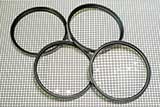Phottix Close-Up Filter
The Raynox DCR-250 is excellent for dabbling in macro photography, but the clip-on holder only works on lenses with filter diameters between 52 and 67 mm - and you get substantial vignetting as you get closer to 67 mm. Since the lenses I use with my Nikon D600 all have filter diameters of 67 mm or more, I went searching for something that would replace the DCR-250.

Phottix Phottix +1, +2, +4, 10X Macro Lens Filters
Close-up lens set
- Specifications
- Magnification
- 1, 2, 4, and 10-Diopter
- Construction
- four single-element lenses
- Front filter thread
- 67mm (other diameters exist)
It's cheap and you get what you pay for, but there are other much better options for not much more. There's no vignetting, but the uncoated lens element has massive amounts of haze and chromatic aberrations. (2/5)
1. What It Is
The Phottix +1, +2, +4, 10X Macro Lens Filters[a] are sold under many brands and in many different sizes, but the core product is the same: a set of four lenses that can be attached to the camera's lens using the filter thread and thus provide the ability to focus much closer than the lens otherwise would. While I paid $40 for my set, it can be had for as little as $12.90[b], which should tell you everything you need to know about the optical quality.
It is, in short, not what you'd use for professional macro photography where you want to emphasize sharp details. But let's have a go with it and see what it can do, using my favorite little camel to benchmark it against the Raynox DCR-250.

D600 + Nikon 70-300 AF-S with Phottix +10 attached.
2017-11-10 12:36
2. Samples
No vignetting, but the uncoated lens element has massive amounts of haze and chromatic aberrations.
3. Versus the Raynox DCR-250
Due to the difference in construction and optical properties, it's not possible to do a pure comparison between this set of four lenses and the DCR-250. The DCR-250 has a strength of 8 diopters, which puts it between the +4 and +10 in the Phottix lens set. It also has vignetting below 180 mm, something the Phottix lenses don't have.
Still, we can put these two lenses to somewhat similar uses and get an approximate feel for them. First, let's look at the DCR-250 at 200 and 300 mm. All photos were shot on a Nikon 70-300 AF-S with aperture set to f/11, mounted on a Nikon D600. The top half is the full image, and the bottom half is a 100% crop near the center where I tried to put the focus:
Next, let's try the Phottix +4 lens. Since the DCR-250 is twice as strong we don't get the same magnification.
Finally, in order to match magnification, we put on the Phottix +10 and shoot it at 160 mm and 240 mm.
To summarize: the Raynox DCR-250 is good, the Phottix +4 is OK, and the Phottix +10 is not all that useful.
4. Summary
It's $40.
As always, you get what you pay for, and a proper macro lens is $500 - $1000, so it's important to set your expectations right when buying this set of four lenses. After all, even at the high price of $40, you can expect an average of $10 per lens, which should pretty much tell you everything you need to know about the optical quality.
That said, it does work, in a fashion. Unlike the Raynox DCR-250, you don't get any vignetting at focal lengths below 200 mm on the 70-300 - but you do get discoloration due to the uncoated lens element at higher magnifications. And higher magnifications is sort of the point of a close-up lens.
If you are looking for a close-up lens, get the DCR-250. You'll get better than 1:1 macro, with acceptable quality, on the cheap. Then, if you find that you want to take photos at lower magnifications, consider buying this set of lenses - or at least get the +4 lens. It's OK. The +1 and +2 are useless to me, so I'm not going to test them.
You can also stack these lenses - but after seeing the results from the +10 I think you might as well upscale the image in Photoshop.
5. Camera Lens Data
This is without the Phottix lens attached.
| Lens | Near Focus Distance | Strength |
|---|---|---|
| Nikon 70-300mm | 1.5 m | 0.67 dptr |
6. Focus Distances
The close-up lens makes the camera lens "nearsighted" - it can no longer focus at infinity. Instead, when the focus is set to infinity, it will focus at the far focus distance in the table. At the same time, the near focus distance gets closer.
| Lens | Close-Up Lens | Near | Far | Span |
|---|---|---|---|---|
| Nikon 70-300mm | +1 | 59.9 cm | 100.0 cm | 40.1 cm |
| Nikon 70-300mm | +2 | 37.5 cm | 50.0 cm | 12.5 cm |
| Nikon 70-300mm | +4 | 21.4 cm | 25.0 cm | 3.6 cm |
| Nikon 70-300mm | +10 | 9.4 cm | 10.0 cm | 0.6 cm |
7. Magnification
The magnification is calculated for an object at the far focus distance with the lens set at infinity.
| Lens | Focal Length | +1 | +2 | +4 | +10 |
|---|---|---|---|---|---|
| Nikon 70-300mm | 70 | 1:14 | 1:7.1 | 1:3.6 | 1:1.4 |
| Nikon 70-300mm | 100 | 1:10 | 1:5 | 1:2.5 | 1:1 |
| Nikon 70-300mm | 150 | 1:6.7 | 1:3.3 | 1:1.7 | 1:0.67 |
| Nikon 70-300mm | 200 | 1:5 | 1:2.5 | 1:1.3 | 1:0.5 |
| Nikon 70-300mm | 250 | 1:4 | 1:2 | 1:1 | 1:0.4 |
| Nikon 70-300mm | 300 | 1:3.3 | 1:1.7 | 1:0.83 | 1:0.33 |

